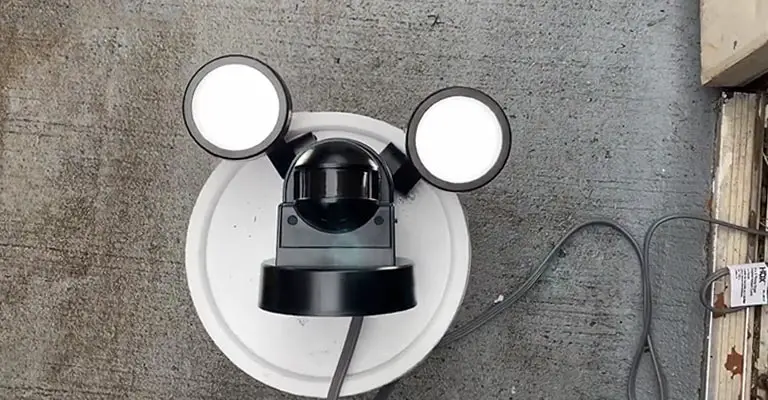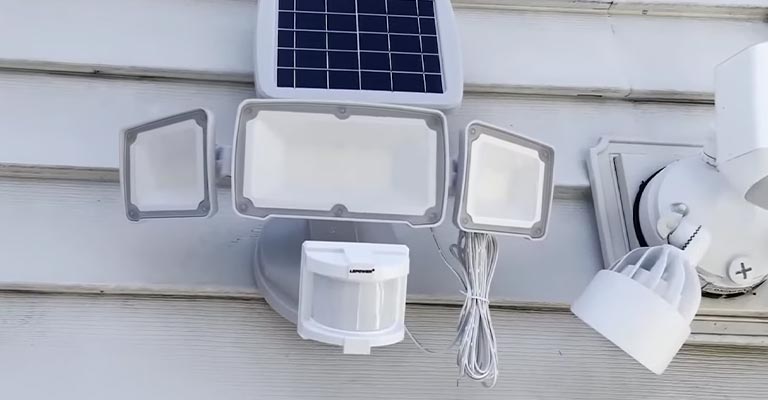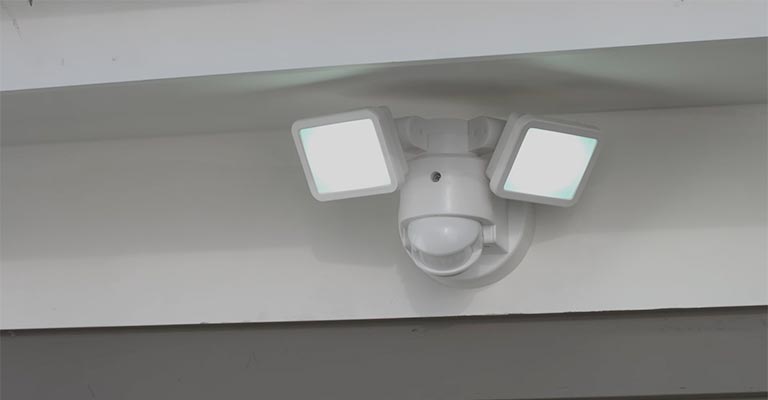Motion sensor lights are a fantastic addition to homes and outdoor spaces, providing convenient illumination while also enhancing security.
These lights are designed to activate in response to movement, typically shutting off automatically after a set period to conserve energy.
However, there are situations where you might want the light to stay on continuously, whether it’s for added safety, prolonged visibility, or simply personal preference.
To keep a motion sensor light on, you can use a simple trick. Quickly switch the motion sensor from ON to OFF and back to ON to override the motion detection, making the light stay on.
If you want to return to motion detection mode, turn the motion sensor off, wait for about 10 seconds, and then turn it on again.
You can return to motion detection mode by turning off the motion sensor, waiting about 10 seconds, and then turning it back on. Once the motion sensor returns to its standard setting, it will begin detecting motion again.
Ways to Make a Motion Sensor Light Stay On

As we now know, a motion sensor light does need to remain on quite a bit.
In addition, it is unappealing that we have to give up the advantage of a regular light that can remain on permanently by simply leaving the switch on after we have installed motion-activated lights throughout the house.
In this case, how do we keep the motion sensor light on? It is possible to power a motion sensor light with a bypass switch so it remains on continuously.
To do this, simply turn the motion sensor ON&OFF quickly to keep it in the ON position, or switch on the indoor lighting with a motion sensor light switch.
Why Does This Work
Depending on the voltage spike or power surge, many old PIR motion sensors can get jammed and stuck after a quick turning ON and OFF has caused a power spike.
When you turn on an air conditioner or washing machine inside the house, you may notice some motion sensor lights suddenly turning on.
It turns on the motion sensor light when a heavy load appliance causes a voltage spike.
Some people claim the “feature” might be built into some old motion sensor lights, but we can’t be sure.
Further, some new and advanced PIR motion sensors are not sensitive to power spikes, so this trick won’t work.
This trick is worth trying since it doesn’t require any installation tools.
How to Trick a Motion Sensor to Stay On?

There are several ways to get a motion sensor to turn on by tricking it.
Use Newspaper Clips
This method is easy and cost-free for creating the illusion that your house is occupied. Put your hand in a newspaper clip and attach it to it.
It should then be placed over the motion detector. As a result of this clever trick, the sensor will falsely detect movement and think someone is walking around.
Use a Security Light
Installing a security light above or near them can enhance outdoor motion sensors. It creates the illusion that there is someone outside and thus makes the sensor stay on longer.
In particular, it can help if you leave your back door open at night when you learn how to trick a motion detector into staying on. The motion sensor light should also stay on while we demonstrate this.
Use a Spoon
Generally, you can use a spoon as a trick by holding it in your hand. A motion sensor’s light hits the spoon’s back and reflects onto your hand to create the illusion of light.
Even if you are not nearby, these clever techniques can fool specific motion sensors into staying on.
Use a Nightlight

Here’s one of the best ways to save in no time if you don’t mind having the nightlight on unnecessarily.
When your home is vacant, unplug the motion-sensing nightlight, and when it’s occupied, keep the nightlight on. When you do this, your home will also appear occupied during daylight hours.
Use a CD Spindle Piece
CD spindle pieces can be used to make a small glowing ball that reflects the motion sensor’s light.
As a result, people seem to be walking back and forth. With this inexpensive method, you can fool your motion sensor into thinking people are present.
Use a Fake Pet
It’s common for motion sensors to detect heat signatures, including your pets’ heat signatures.
You should let your pet bird out when no one is around when you keep your pet bird in its cage at home. By doing this, the motion sensor will perceive there is a human presence in the room.
Use a Piece of Aluminum Foil
You can make a small pocket out of aluminum foil by making a small pocket in the center of it.
Place your hand within the pocket, fooling the motion sensor into believing someone is present. Creating this illusion makes your house appear occupied.
Use a Glow-in-the-Dark Ball
Glow-in-the-dark balls emit light that can trick the motion sensor into thinking something is nearby, preventing it from turning off.
Using this method, you can create the impression that your house is occupied for free. Using such a trick tricks a motion sensor into staying on.
Use a Fake Spider
If you move a fake toy spider around your house occasionally, you can easily fool your motion sensor into sensing a spider.
Consequently, the motion detector will believe that there are crawling spiders, which will result in the lights staying on for an extended period.
Use a Motion Sensor Switch With an On/Off Feature
Using a direct motion sensor switch with an ON/OFF mode is the best option if an occupancy or vacancy wall switch controls your indoor motion-activated light fixture.
If the ON mode is turned on, you will be able to keep the light on for a permanent period, and if the OFF mode is selected, the light will be kept off forever.
The motion sensor switch has a manual mode to operate like a standard light switch when no motion is detected, even with motion detection enabled.
With a little press of a few switches on the switch panel, you can return to normal motion detection mode.
A Motion Sensor Light With Built-in Sensor
Since the motion sensor is integrated into the light, you only get three wires from it. It is exactly the same theory and wiring as before, except you need to disassemble and rewire the motion sensor light.
A light might be easy to rewire, while another might not be. A light that cannot be easily rewired is recommended to be upgraded with one that has an ON/OFF feature built in, which must be controlled manually if it is not easy to rewire.
Please note that this solution works for outdoor and indoor motion sensors, but it primarily controls outdoor lights. To have better options for indoor motion sensor lights, we can use a motion sensor switch with an ON/OFF feature.
There are many indoor lights with manual control settings since home users frequently adjust them, such as motion sensor strips and night lights, unlike outdoor lights, which are seldom adjusted once installed.
A Light Connected to a Motion Detector
Since the wiring of motion sensor lights is clear, it is fairly easy to add a switch if they are a combination of a motion detector and a standard light.
You should choose a switch from your house that is not in line with the sensor and light and connect the hotwire output to the input of your light (which is also connected to the motion sensor’s output).
It’s just that simple. As a result, both the motion sensor and manual switch can power the light at the same time. You can use a three-way switch or even a dual switch if you prefer for more precise control.
For example, shutting off the light isn’t possible using the previous setup because the motion sensor still provides power to the light. You can opt to keep the light off by adding a main switch to the motion sensor.
It’s simple to connect the main switch’s output to both switch and motion sensor inputs. Thus, you can turn off the main switch to keep the light off as long as you like.
Hardwire a Switch to Bypass the Sensor
You can hardwire a separate light switch parallel to the motion sensor to power the light separately. Using this method, either the motion sensor hot wire or the light switch can power the light.
You can turn on the switch to keep the light on if necessary. With this switch, the light is powered directly from the switch’s hotwire.
Whether the motion detector detects motion or not, it is not essential. Once the switch is turned on, the light will remain on.
Turning off the switch to return the light to motion-detecting mode is possible. In the future, the motion detector will be the only source of power for the light.
When the motion sensor detects a valid motion signal, it will turn on the light and disable it when no one is present.
Although the hardware bypass method requires some manual work, it is guaranteed. Based on your sensor light, this can be pretty simple or slightly complicated.
Why Do We Want the Light to Stay On
Motion sensor lights are designed to automatically turn off if no motion is detected after a set time.
After setting a 20-minute timer, your light will remain on for another 20 minutes after the empty space, providing consistent illumination.
Despite having a time delay range of 30 seconds to 30 minutes, the motion sensor light can be used in most scenarios. It is still essential sometimes to keep the light on to have a more pleasant experience.
Outdoor lighting, such as motion sensor lights, is ideal for illuminating backyards and gardens. Despite this, it is possible that we would rather have the light on all night regardless of whether motion is detected in the yard or not.
You should leave the light on for as long as necessary when you are having a party at night in your garden.
As long as the motion detector is initially positioned to detect people along the pathway and not the current party area, it might have trouble detecting motion, resulting in the light not staying on.
This can be a massive headache when party time rolls around. The same applies to motion sensor lights that are installed indoors. Often, we want the light in the stairwell or study to stay on for a long time, regardless of whether motion is detected.
For example, when we have a good book read in the study, the light might frequently be ON and OFF when the motion sensor is far from us and cannot detect fine movements like turning pages.
Final Words
Sometimes, we need to keep the lights on for particular reasons. Standard lights are generally inferior to motion sensor lights. An ongoing and exciting problem is finding the right balance between motion activation and manual control.
This guide aims to help you determine what’s best for you so that you can keep your motion sensor light ON and enjoy your lighting throughout the day.







